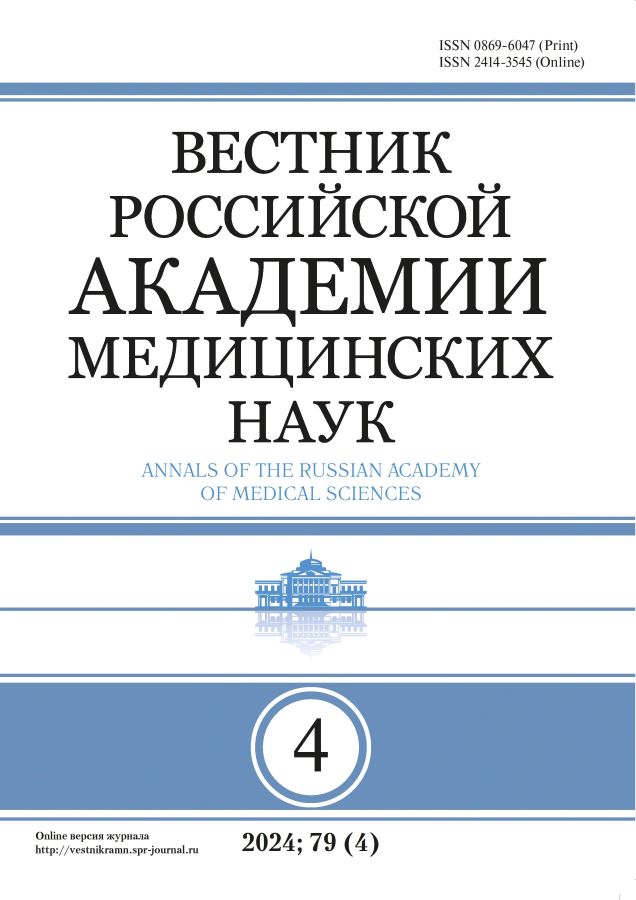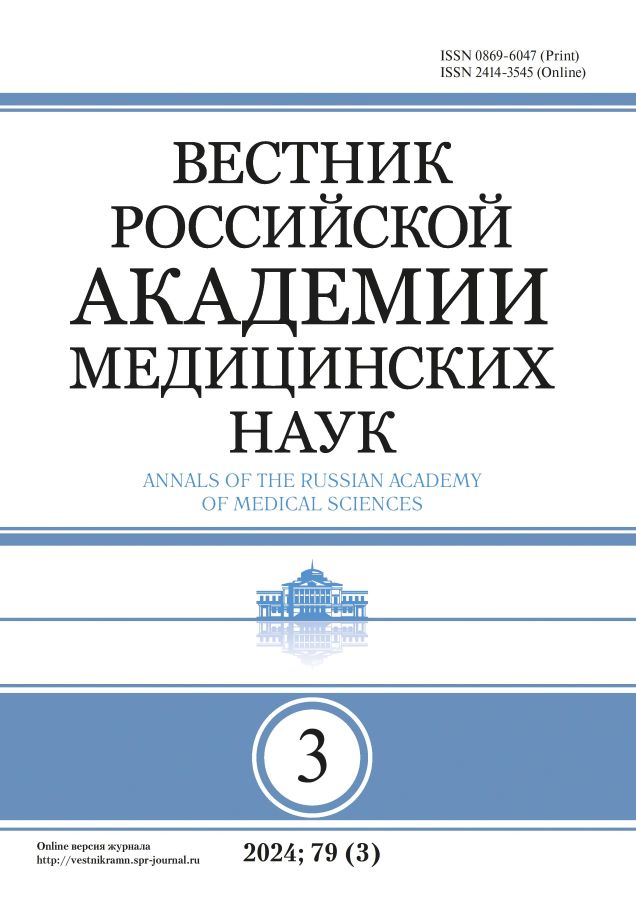Роль искусственного интеллекта в снижении риска развития побочных реакций при множественных лекарственных взаимодействиях
- Авторы: Шимановский Н.Л.1,2, Судаков В.А.1, Береговых В.В.3
-
Учреждения:
- Российский экономический университет имени Г.В. Плеханова
- Российский национальный исследовательский медицинский университет имени Н.И. Пирогова
- Российская академия наук
- Выпуск: Том 79, № 3 (2024)
- Страницы: 250-260
- Раздел: АКТУАЛЬНЫЕ ВОПРОСЫ ФАРМАКОЛОГИИ И ФАРМАЦИИ
- Дата публикации: 15.08.2024
- URL: https://vestnikramn.spr-journal.ru/jour/article/view/12464
- DOI: https://doi.org/10.15690/vramn12464
- ID: 12464
Цитировать
Полный текст
Аннотация
Рассмотрены имеющиеся сведения о роли полипрагмазии в увеличении частоты множественных лекарственных взаимодействий, когда одно лекарственное средство взаимодействует с двумя или более другими лекарственными средствами, увеличивая риск связанных с ними побочных эффектов. Описано применение сетевого анализа и искусственного интеллекта для прогнозирования развития клинически значимых побочных реакций в условиях полифармакотерапии. Рассмотрены механизмы фармакодинамического и фармакокинетического взаимодействия лекарственных средств в развитии побочных реакций и отмечены лекарственные средства, потенциально несущие повышенный риск при множественных лекарственных взаимодействиях. Наиболее опасными препаратами, участвующими в лекарственных взаимодействиях, оказались психотропные средства, на долю которых приходилось около трети всех применимых лекарственных средств. Наиболее распространенными серьезными потенциальными осложнениями, связанными с этим взаимодействием, были серотониновый синдром, судороги, удлинение интервала QT и кровотечение. Предложены графовые вероятностные модели, модели машинного обучения для анализа достоверных источников медицинских данных, факторные модели, позволяющие оценить риски совместного приема двух и более препаратов. Данные модели реализуются в программном обеспечении и могут быть внедрены в системы поддержки принятия клинических решений. Сделан вывод, что применение искусственного интеллекта может снизить риск развития побочных реакций при полифармакотерапии, особенно у пожилых пациентов.
Полный текст
Об авторах
Николай Львович Шимановский
Российский экономический университет имени Г.В. Плеханова; Российский национальный исследовательский медицинский университет имени Н.И. Пирогова
Автор, ответственный за переписку.
Email: shimann@yandex.ru
ORCID iD: 0000-0001-8887-4420
SPIN-код: 5232-8230
д.м.н., профессор, член-корреспондент РАН
Россия, Москва; МоскваВладимир Анатольевич Судаков
Российский экономический университет имени Г.В. Плеханова
Email: sudakov@ws-dss.com
ORCID iD: 0000-0002-1658-1941
SPIN-код: 1614-4760
д.т.н., доцент
Россия, МоскваВалерий Васильевич Береговых
Российская академия наук
Email: beregovykh@ramn.ru
ORCID iD: 0000-0002-0210-4570
SPIN-код: 5940-7554
д.т.н., профессор, академик РАН
Россия, МоскваСписок литературы
- Kantor ED, Rehm CD, Haas JS, et al. Trends in prescription drug use among adults in the United States from 1999–2012. JAMA. 2015;314(17):1818–1831. doi: https://doi.org/10.1001/jama.2015.13766
- Masnoon N, Shakib S, Kalisch-Ellett L, Caughey GE. What is polypharmacy? A systematic review of definitions. BMC Geriatr. 2017;17(1):230. doi: https://doi.org/10.1186/s12877-017-0621-2
- Sutherland JJ, Daly TM, Liu X, et al. Co-prescription trends in a large cohort of subjects predict substantial drug-drug interactions. PloS One. 2015;10(3):e0118991. doi: https://doi.org/10.1371/journal.pone.0118991
- Becker ML. Hospitalisations and emergency department visits due to drug-drug interactions: a literature review. Pharmacoepidemiol Drug Saf. 2007;16(6):641–651. doi: https://doi.org/10.1002/pds.1351
- Hampton LM, Daubresse M, Chang HY, et al. Emergency Department Visits by Adults for Psychiatric Medication Adverse Events. JAMA Psychiatry. 2014;71(9):1006–1014. doi: https://doi.org/10.1001/jamapsychiatry.2014.436
- Roughead EE. Multidrug interactions: the current clinical and pharmacovigilance challenge. Journal of Pharmacy Practice and Research. 2015;45(2):138–139. doi: https://doi.org/10.1002/jppr.1101
- FDA. Preventable Adverse Drug Reactions: A Focus on Drug Interactions FDA 2021. Available from: https://www.fda.gov/drugs/postmarket-drugsafety-information-patients-and-providers/amiodarone-hydrochloridemarketed-cordarone-and- pacerone-information
- Anand TV, Wallace BK, Chase HS. Prevalence of potentially harmful multidrug interactions on medication lists of elderly ambulatory patients. BMC Geriatr. 2021;219(1):648. doi: https://doi.org/10.1186/s12877-021-02594-z
- Cerner Solutions Drug Database. Available from: https://www.cerner.com/ solutions/drug- database
- Tarjan R. Depth-First Search and Linear Graph Algorithms. SIAM Journal on Computing. 1972;1(2):146–160. doi: https://doi.org/10.1137/0201010
- Aljadani R, Aseeri M. Prevalence of drug-drug interactions in geriatric patients at an ambulatory care pharmacy in a tertiary care teaching hospital. BMC Res Notes. 2018;11(1):234. doi: https://doi.org/10.1186/s13104-018-3342-5
- Khalil H, Huang C. Adverse drug reactions in primary care: a scoping review. BMC Health Serv Res. 2020;20(1):5. doi: https://doi.org/10.1186/s12913-019-4651-7
- Laatikainen O, Sneck S, Bloigu R, et al. Hospitalizations Due to Adverse Drug Events in the Elderly — A Retrospective Register Study. Front Pharmacol. 2016;7:358. doi: https://doi.org/10.3389/fphar.2016.00358
- Létinier L, Cossin S, Mansiaux Y, et al. Risk of Drug-Drug Interactions in Out-Hospital Drug Dispensings in France: Results from the Drug-Drug Interaction Prevalence Study. Front Pharmacol. 2019;10:265. doi: https://doi.org/10.3389/fphar.2019.00265
- Jeon SM, Park S, Kim D, et al. Risk of seizures associated with antipsychotic treatment in pediatrics with psychiatric disorders: a nested case-control study in Korea. Eur Child Adolesc Psychiatry. 2021;30(3):391–399. doi: https://doi.org/10.1007/s00787-020-01525-4
- Buckley NA, Dawson AH, Isbister GK. Serotonin syndrome. BMJ. 2014;348:g1626. doi: https://doi.org/10.1136/bmj.g2159.
- Frommeyer G, Fischer C, Ellermann C, et al. Additive Proarrhythmic Effect of Combined Treatment with QT-Prolonging Agents. Cardiovasc Toxicol. 2018;18(1):84–90. doi: https://doi.org/10.1007/s12012-017-9416-0
- Spina E, Santoro V, D’Arrigo C. Clinically relevant pharmacokinetic drug interactions with second-generation antidepressants: An update. Clin Ther. 2008;30(7):1206–1227. doi: https://doi.org/10.1016/s0149-2918(08)80047-1
- Hemeryck A. Selective serotonin reuptake inhibitors and cytochrome P-450 mediated drug-drug interactions: an update. Currt Drug Metab. 2002;3(1):13–37. doi: https://doi.org/10.2174/1389200023338017
- Boyce RD. Age-related changes in antidepressant pharmacokinetics and potential drug-drug interactions: a comparison of evidence-based literature and package insert information. Am J Geriatr Pharmacother. 2012;10(2):139–150. doi: https://doi.org/10.1016/j.amjopharm.2012.01.001
- Marusic S, Bacic-Vrca V, Obreli Neto PR, et al. Actual drug-drug interactions in elderly patients discharged from internal medicine clinic: a prospective observational study. Eur J Clin Pharmacol. 2013;69(9):1717–1724. doi: https://doi.org/10.1007/s00228-013-1531-7
- Sánchez-Fidalgo S, Guzmán-Ramos MI, Galván-Banqueri M, et al. Prevalence of drug interactions in elderly patients with multimorbidity in primary care. Int J Clin Pharm. 2017;39(2):343–353. doi: https://doi.org/10.1007/s11096-017-0439-1
- Leiss W, Méan M, Limacher A, et al. Polypharmacy is Associated with an Increased Risk of Bleeding in Elderly Patients with Venous Thromboembolism. J Gen Intern Med. 2015;30(1):17–24. doi: https://doi.org/10.1007/s11606-014-2993-8
- Ray WA, Stein CM, Murray KT, et al. Association of Antipsychotic Treatment with Risk of Unexpected Death Among Children and Youths. JAMA Psychiatry. 2019;76(2):162–171. doi: https://doi.org/10.1001/jamapsychiatry.2018.3421
- Danielsson B, Collin J, Jonasdottir Bergman G, et al. Antidepressants and antipsychotics classified with torsades de pointes arrhythmia risk and mortality in older adults — a Swedish nationwide study. Br J Clin Pharmacol. 2016;81(4):773–783. doi: https://doi.org/10.1111/bcp.12829
- Sicouri S. Sudden cardiac death secondary to antidepressant and antipsychotic drugs. Expert Opin Drug Saf. 2008;7(2):181–194. doi: https://doi.org/10.1517/14740338.7.2.181
- Ray WA, Chung CP, Murray KT, et al. Atypical Antipsychotic Drugs and the Risk of Sudden Cardiac Death. N Engl J Med. 2009;360(3):225–235. doi: https://doi.org/10.1056/NEJMoa0806994
- Schneeweiss S, Avorn J. Antipsychotic Agents and Sudden Cardiac Death — How Should We Manage the Risk? N Engl J Med. 2009;360(3):294–296. doi: https://doi.org/10.1056/NEJMe0809417
- Risgaard B. Sudden cardiac death in young adults with previous hospital-based psychiatric inpatient and outpatient treatment: a nationwide cohort study from Denmark. J Clin Psychiatry. 2015;76(9):e1122–1129. doi: https://doi.org/10.4088/JCP.14m09742
- Zhu J, Hou W, Xu Y, et al. Antipsychotic drugs and sudden cardiac death: A literature review of the challenges in the prediction, management, and future steps. Psychiatry Res. 2019;281:112598. doi: https://doi.org/10.1016/j.psychres.2019.112598
- Phansalkar S, van der Sijs H, Tucker AD, et al. Drug-drug interactions that should be non-interruptive in order to reduce alert fatigue in electronic health records. J Am Med Inform Assoc. 2013;20(3):489–493. doi: https://doi.org/10.1136/amiajnl-2012-001089
- Hanlon JT, Semla TP, Schmader KE. Alternative Medications for Medications in the Use of High-Risk Medications in the Elderly and Potentially Harmful Drug-Disease Interactions in the Elderly Quality Measures. J Am Geriatr Soc. 2015;63(12):e8–e18. doi: https://doi.org/10.1111/jgs.13807
- American Geriatrics Society 2019 Updated AGS Beers Criteria® for Potentially Inappropriate Medication Use in Older Adults. J Am Geriatr Soc. 2019;67:674–694. doi: https://doi.org/10.1111/ jgs.15767
- Furyk JS, Meek RA, Egerton-Warburton D. Drugs for the treatment of nausea and vomiting in adults in the emergency department setting. Cochrane Database Syst Rev. 2015;2015(9):CD010106. doi: https://doi.org/10.1002/14651858.CD010106.pub2
- Potter K, Flicker L, Page A, et al. Deprescribing in Frail Older People: A Randomised Controlled Trial. PLoS One. 2016;11(3):e0149984. doi: https://doi.org/10.1371/journal.pone.0149984
- Mojtabai R, Olfson M. National Trends in Psychotropic Medication Polypharmacy in Office-Based Psychiatry. Arch Gen Psychiatry. 2010;67(1):26–36. doi: https://doi.org/10.1001/archgenpsychiatry.2009.175
- Kok RM, Reynolds CF, III. Management of Depression in Older Adults: A Review. JAMA. 2017;317(20):2114–2122. doi: https://doi.org/10.1001/jama.2017.5706
- Brooks JO, Hoblyn JC. Neurocognitive Costs and Benefits of Psychotropic Medications in Older Adults. J Geriatr Psychiatry Neurol. 2007;20(4):199–214. doi: https://doi.org/10.1177/0891988707308803
- Petit-Monéger A, Jouhet V, Thiessard F, et al. Appropriateness of psychotropic drug prescriptions in the elderly: structuring tools based on data extracted from the hospital information system to understand physician practices. BMC Health Serv Res. 2019;19(1):272. doi: https://doi.org/10.1186/s12913-019-4064-7
- Leung GM, Johnston JM, Tin KYK, et al. Randomised controlled trial of clinical decision support tools to improve learning of evidence-based medicine in medical students. BMJ. 2003;327(7423):1090. doi: https://doi.org/10.1136/bmj.327.7423.1090
- Nauta KJ, Groenhof F, Schuling J, et al. Application of the STOPP/START criteria to a medical record database. Pharmacoepidemiol Drug Saf. 2017;26(10):1242–1247. doi: https://doi.org/10.1002/pds.4283
- Boyer EW. The serotonin syndrome. N Engl J Med. 2005;352(11):1112–1120. doi: https://doi.org/10.1056/NEJMra041867
- Volpi-Abadie J, Kaye AM, Kaye AD. Serotonin syndrome. Ochsner J. 2013;13(4):533–540.
- Steinert T, Fröscher W. Epileptic Seizures Under Antidepressive Drug Treatment: Systematic Review. Pharmacopsychiatry. 2018;51(4):121–135. doi: https://doi.org/10.1055/s-0043-117962
- Coupland C, Dhiman P, Morriss R, et al. Antidepressant use and risk of adverse outcomes in older people: population-based cohort study. BMJ. 2011;343:d4551. doi: https://doi.org/10.1136/bmj.d4551
- Cipriani A, Furukawa TA, Salanti G. Comparative Efficacy and Acceptability of 21 Antidepressant Drugs for the Acute Treatment of Adults with Major Depressive Disorder: A Systematic Review and Network Meta-Analysis. Focus (Am Psychiatr Publ). 2018;16(4):420–429. doi: https://doi.org/10.1176/appi.focus.16407
- Chetverushkin BN, Sudakov VA. Factor Model for the Study of Complex Processes. Doklady Mathematics. 2019;100(3):514–518. doi: https://doi.org/10.1134/S1064562419060036
- Olvey EL, Clauschee S, Malone DC. Comparison of Critical Drug–Drug Interaction Listings: The Department of Veterans Affairs Medical System and Standard Reference Compendia. Clin Pharmacol Ther. 2010;87(1):48–51. doi: https://doi.org/10.1038/clpt.2009.198
- Schjøtt J, Schjøtt P, Assmus J. Analysis of consensus among drug interaction databases with regard to combinations of psychotropics. Basic Clin Pharmacol Toxicol. 2019;126(2):126–32. doi: https://doi.org/10.1111/ bcpt.13312
- Ayvaz S, Horn J, Hassanzadeh O, et al. Toward a complete dataset of drug-drug interaction information from publicly available sources. J Biomed Inform. 2015;55:206–217. doi: https://doi.org/10.1016/j.jbi.2015.04.006
- Muhič N, Mrhar A, Brvar M. Comparative analysis of three drug-drug interaction screening systems against probable clinically relevant drug-drug interactions: a prospective cohort study. Eur J Clin Pharmacol. 2017;73(7):875–882. doi: https://doi.org/10.1007/s00228-017-2232-4
- Fung KW, Kapusnik-Uner J, Cunningham J, et al. Comparison of three commercial knowledge bases for detection of drugdrug interactions in clinical decision support. J Am Med Inform Assoc. 2017;24(4):806–812. doi: https://doi.org/10.1093/jamia/ocx010
- Cornu P. High-priority and low-priority drug-drug interactions in different international electronic health record systems: A comparative study. Int J Med Inform. 2018;111:165–171. doi: https://doi.org/10.1016/j.ijmedinf.2017.12.027
- Aquilante CL, Langaee TY, Lopez LM, et al. Influence of coagulation factor, vitamin К epoxide reductase complex subunit 1, and cytochrome P450 2C9 gene polymorphisms on warfarin dose requirements. Clin Pharmacol Ther. 2006;79(4):291–302. doi: https://doi.org/10.1016/j.clpt.2005.11.01128
- Higashi MK, Veenstra DL, Kondo LM, et al. Association between CYP2C9 genetic variants and anticoagulation-related outcomes during warfarin therapy. JAMA. 2002;287(13):1690–1698. doi: https://doi.org/10.1001/jama.287.13.1690
- Кукес ВГ, ред. Клиническая фармакогенетика. — М.: ГЭОТАР-Медиа, 2007. [Kukes VG, ed. Clinical pharmacogenetics. Moscow: GEOTAR-Media; 2007. (In Russ.)]
- Ramsey LB, Johnson SG, Caudle KE, et al. The clinical pharmacogenetics implementation consortium guideline for SLCO1B1 and simvastatin-induced myopathy: 2014 update. Clin Pharmacol Ther. 2014;96(4):423–8. doi: https://doi.org/10.1038/clpt.2014.125
- Шимановский Н.Л., Епинетов М.А., Мельников М.Я. Молекулярная и нанофармакология. — М.: Физматлит, 2009. — 622 с. [Shimanovsky NL, Epinetov MA, Melnikov MYa. Molecukar and nanophaarmacology. Moscow: Physmatlit; 2009. 622 p. (In Russ.)] Available from: https://biblioclub.ru/index.php?page=book&id=69136
- Tatonetti NP, Denny JC, Murphy SN, et al. Detecting Drug Interactions from Adverse-Event Reports: Interaction Between Paroxetine and Pravastatin Increases Blood Glucose Levels. Clin Pharmacol Ther. 2011;90(1):133–142. doi: https://doi.org/10.1038/clpt.2011.83
- Lorberbaum T, Sampson KJ, Chang JB, et al. Coupling Data Mining and Laboratory Experiments to Discover Drug Interactions Causing QT Prolongation. J Am Coll Cardiol. 2016;68(16):1756–1764. doi: https://doi.org/10.1016/j.jacc.2016.07.761
- Lorberbaum T, Sampson KJ, Woosley RL, et al. An Integrative Data Science Pipeline to Identify Novel Drug Interactions that Prolong the QT Interval. Drug Saf. 2016;39(5):433–441. doi: https://doi.org/10.1007/s40264-016-0393-1
Дополнительные файлы









